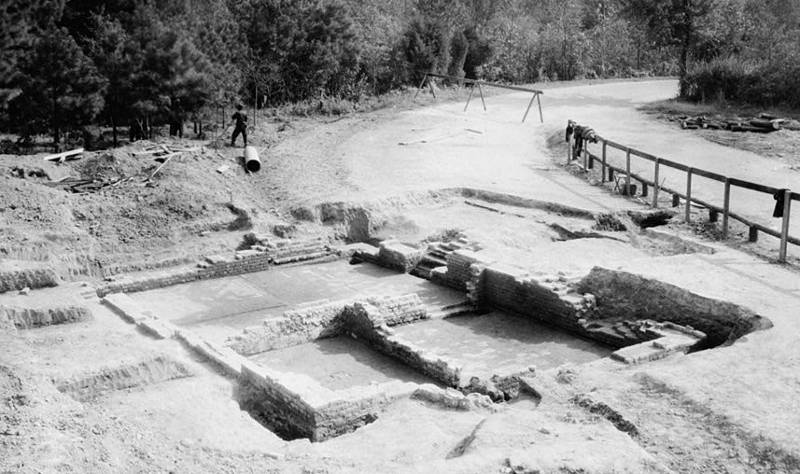
archeologists and historians have pieced together much of the story of Jamestown
Source: Library of Congress, Architectural Remains, Unit A, Sub-unit 39, Jamestown, James City County, VA

archeologists and historians have pieced together much of the story of Jamestown
Source: Library of Congress, Architectural Remains, Unit A, Sub-unit 39, Jamestown, James City County, VA
The capital of Virginia moved from Jamestown to Williamsburg in 1699, a year after the statehouse burned. The old colonial capital reverted back to farmland. The brick church, which had been built sometime in the 1600's, was abandoned in the 1750's and fell into ruin.1
Jamestown was largely ignored during its 100th anniversary. The 200th and 250th anniversaries drew more attention, but it was not until the 300th anniversary ("tercentennial") of the settlement in 1907 that preservation became a priority.
The 100th anniversary of the founding of Jamestown, in 1707, occurred only eight years after the capital had been moved to Williamsburg. Colonial officials did not arrange for a major public celebration at the recently-abandoned site of the colonial capital.
The 200th anniversary in 1807 was marked by a "Grand National Jubilee" organized by the College of William and Mary. A dozen or more vessels sailed to the site, and 3,500 people crowded onto the island to explore and hear orations. The 250th anniversary in 1857 attracted up to 8,000 people, including former president John Tyler.2
Soon afterwards in 1862, the Confederate Army built Fort Pocahontas on Jamestown Island to block the advance of the Union Army up the Peninsula. The Civil War fort was, by chance, placed on top of the western edge of the 1607 fort. The earthworks of the Confederate fort did preserve some artifacts of the earlier colonial fort.
During the first days of Jamestown, Spanish Ambassador Zuniga in London had an effective spy network. While many documents associated with the Virginia Company have disappeared, Zuniga's intelligence reports and a copy of the first known map of Jamestown survived in the Spanish archives.
In 1862, Confederate soldiers gathered dirt for the walls of Fort Pocahontas at the location where the Zuniga map portrayed what may be an extension of the original triangular 1607 fort. His drawing may not be an accurate drawing of the location of early colonial structures, but the assumption that Zuniga's map showed an extension of the fort can not be tested through modern archeological techniques. That part of Jamestown was destroyed by the 1862 earth mining, when the site of a 1607 military fort created to protect against the Spanish threat was altered by an 1862 military fortification constructed during the Civil War.3
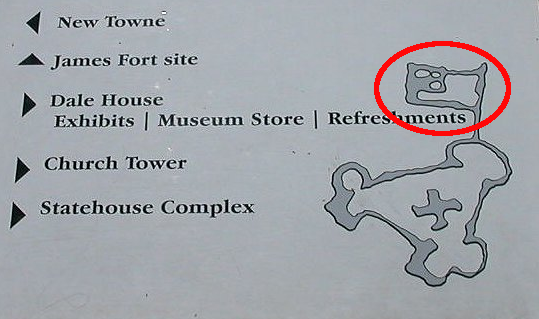
Ambassador Zuniga's map of the 1607 Jamestown fort (shown here on a modern interpretive sign) included a section that was destroyed in 1862 during construction of Confederate Fort Pocahontas
Preservation of the historic site began in 1893. The Barney family, which owned all of the land at Jamestown, donated a 22.5-acre portion to the Association for the Preservation of Virginia Antiquities, a non-government organization that focused on Virginia's colonial-era historical sites while other organizations emphasized memorializing of the Civil War.
The donated portion included the old church tower. It was recognized as a relic from the past, but thought to have been built at least 300 yards (the distance of a football field) away from the 1607 fort.
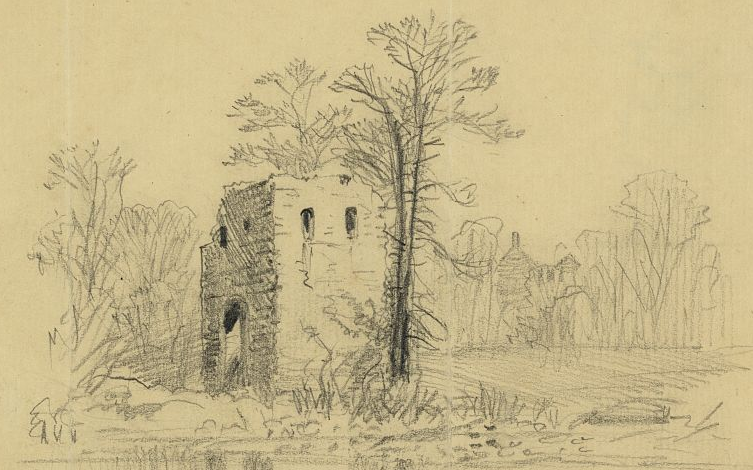
in 1864, only the tower remained from the church that was constructed in the 1600's
Source: Library of Congress, Ancient Church. Jamestown 1864
Since acquiring the land, the Association for the Preservation of Virginia Antiquities (now Preservation Virginia) has partnered with the Federal government to conduct archeology, research history, and interpret the story of Jamestown. For the 300th anniversary in 1907, the Federal government erected a 103-foot tall Jamestown Tercentenary Monument at the privately-owned site of Jamestown.
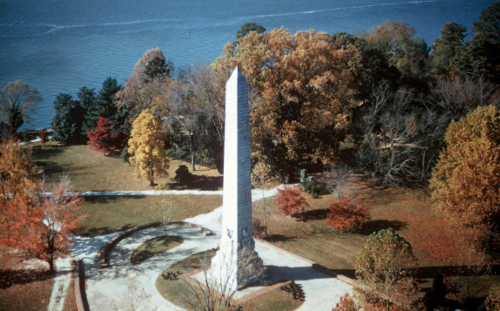
the Jamestown Tercentenary Monument was built by the Federal government for Jamestown's 300th anniversary in 1907
Source: National Park Service, Jamestown Visitor Center
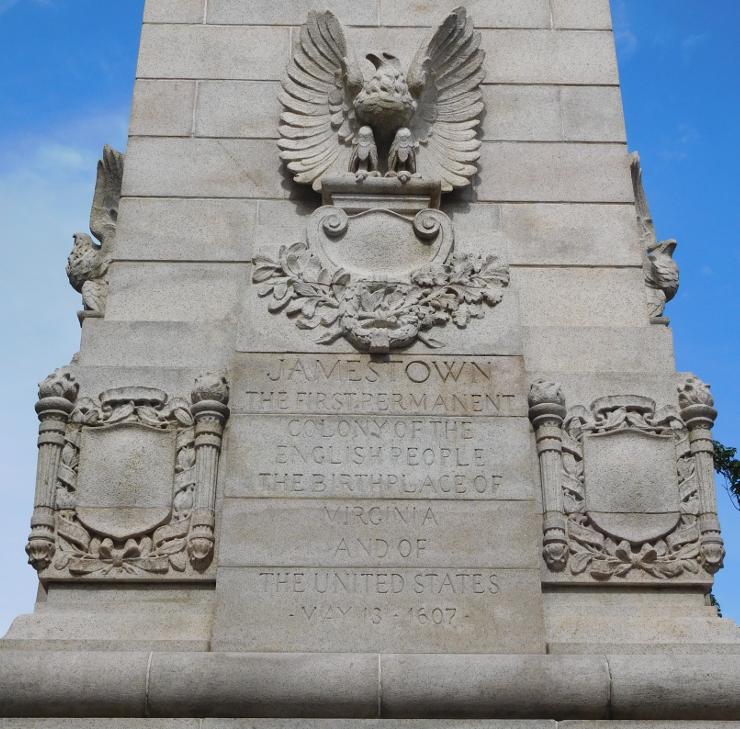
the Federal government built a monument in 1907 that asserted Virginia's claim to being the primary site that led to democracy in North America
Federal acquisition of a portion of Jamestown Island started after President Hoover used the presidential authority in the Antiquities Act, and established Colonial National Monument in 1930. The National Park Service acquired the remaining 1,560 acres of private land on Jamestown Island in 1934, outside of the parcel owned by the Association for the Preservation of Virginia Antiquities.
President Hoover had established a national monument by executive action in 1930. Congress upgraded its status and protection in 1936, when it passed legislation that converted Colonial National Monument into Colonial National Historical Park.4
When the Barney family donated the land, everyone thought the James River has washed away the site of the Jamestown settlement where John Smith had lived in 1607-1609 and Pocahontas had married John Rolfe in 1614. Local tradition held that a single cypress tree, isolated within the river 1090 yards from the shoreline, marked the old edge of the peninsula ("island") where Edward Maria Wingfield decided to settle in 1607. The conventional wisdom was that the James River had eroded almost 300 feet of land, carrying the remains of the original fort downstream to the Chesapeake Bay.
Nonetheless, the "patriotic women" of the Association for the Preservation of Virginia Antiquities convinced the Federal government to build a seawall in 1901 to protect the remainder of the island.5
The Association for the Preservation of Virginia Antiquities spurred the initial planning to celebrate the 300th anniversary of the settlement at Jamestown in 1900, and other non-government organizations contributed as well. The Daughters of the American Revolution sponsored archeological digging and funded construction of a memorial building.
The Pocahontas Memorial Association provided a statue. It represented Pocahontas in a costume more suitable for someone who lived on the plains of the western United States, and was one of the few acknowledgements that the site had been occupied for thousands of years before the English colonists arrived.6
As their contribution, the National Society of Colonial Dames of America rebuilt the last version of the church at Jamestown. That structure, the fifth church at Jamestown had been erected in the 1680's after the colonial capital burned during Bacon's Rebellion in 1676. The last church was abandoned in the 1750's after the capital moved to Williamsburg and the local population declined. Bricks were scavenged for other purposes, including the wall around the graveyard.
When the Barney's deeded 22.5 acres to the Association for the Preservation of Virginia Antiquities, only the brick tower of the church still remained. The Association discovered the adjacent cobblestone foundation of the third church built in 1617.
The church tower and old foundation remains were considered especially significant. They were treated as a direct connection to the structure used for the first meeting in 1619 of an elected representative assembly for colonists in North America, the first General Assembly. A temporary frame building was built to protect the foundation, and it was replaced when the Colonial Dames reconstructed the church in 1907.
After two years of digging, in January, 2019 archeologists at the site exposed the brick foundation of the 1617 church. It was a 20x50 foot structure. The replacement church in 1639 was smaller, suggesting the population at Jamestown had dropped while settlers moved to other areas along the James and York rivers.
The builders of the 1639 brick church constructed a shell outside the walls of the timber 1617 church, leaving the existing structure intact while the new brick structure was built. Work stopped when the brick church was only 2/3 complete. Not until 1647 was the brick church completed, at which time the 1617 timber frame was finally disassembled.
Early archeology in the 1880's revealed that the church tower, whose age was still undetermined, had been built on top of the western wall of the 1607 church. A five-inch layer of concrete covered the old foundation. The concrete created a logistical challenge for the 2016-19 excavations, but also had provided protection from disturbance of the bricks underneath. The research digging was on a tight 2019 deadline. The General Assembly was scheduled to reassemble at the site in July, 2019 to commemorate the 400th anniversary of the first legislative group elected by colonists in North America.7
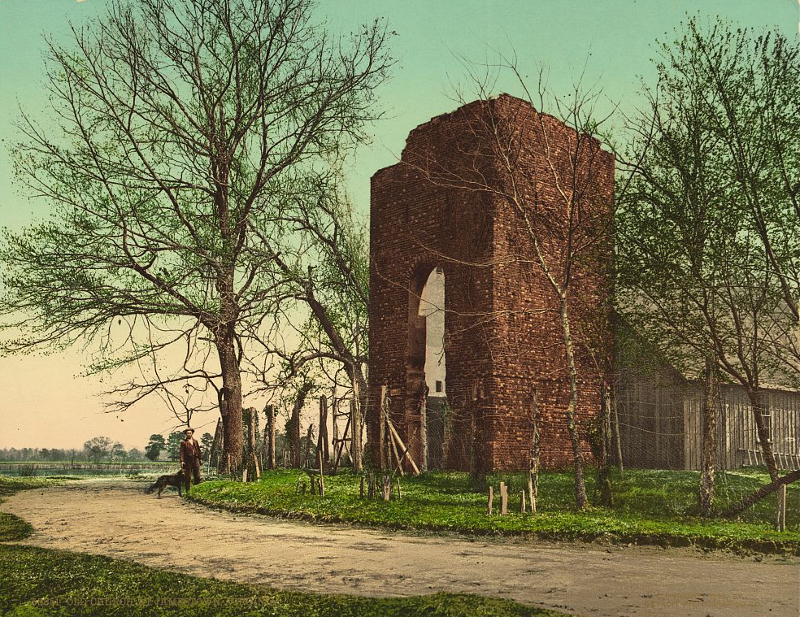
the tower in 1902, before the Colonial Dames of America built a brick reconstruction of the associated church (the temporary wooden frame building protected the foundations of the 1617 church)
Source: Library of Congress, Old Church at Jamestown, Virginia
Centering the 400th anniversary commemoration at Jamestown created logistical challenges. Because the site was so small, events to commemorate the 300th anniversary in 1907 were not held at the historic site itself. The 1907 Jamestown Exposition was held in Hampton Roads, where local business leaders anticipated an economic benefit from tourism. Exhibition buildings were constructed on the south side of the James River at Sewells Point in Norfolk.
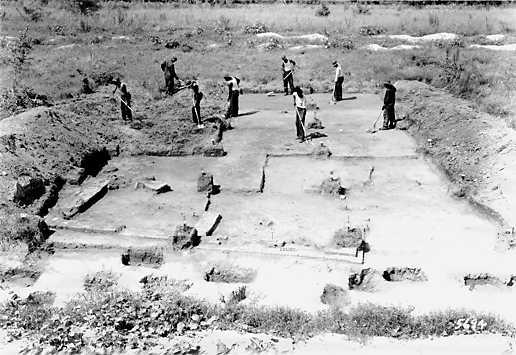
in the 1930's, archeology at Jamestown started with African-American workers doing the initial digging
Source: National Park Service, NPS History Collection - Colonial National Historical Park
In 1907. everyone thought the original fort had washed away; there was nothing special to see at the historic location except a brick church tower. The old site at Jamestown lacked the facilities to handle the crowds expected at the exposition, and Sewells Point offered better access for tourists travelling by steamboat. Leaders in Hampton Roads were willing to commit local funding in the expectation that the Jamestown Exposition would generate profits for local businesses.
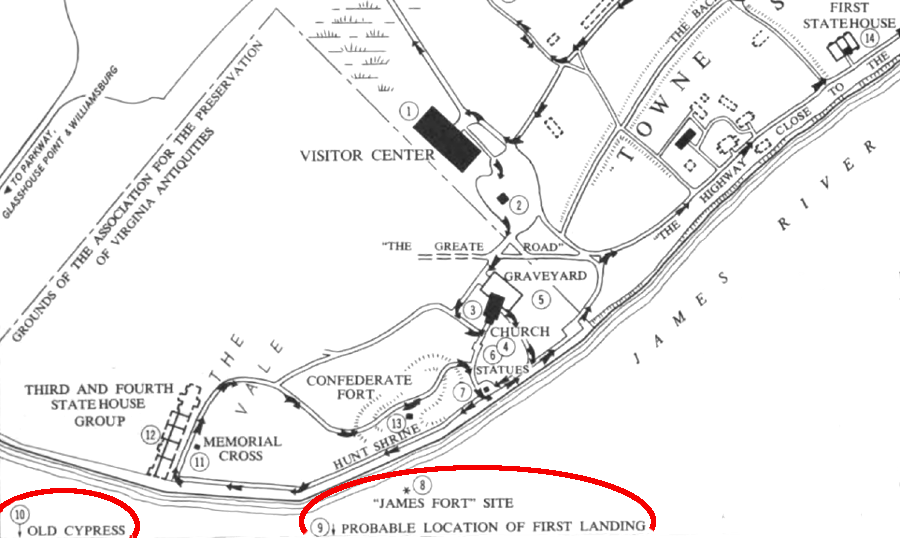
for over a century, the original site of the fort at Jamestown was thought to have been eroded away by the river
Source: Jamestown, Virginia: The Townsite and Its Story
In 1957, the 350th anniversary of the arrival of English settlers triggered new investment at the historic location by the National Park Service. The Federal agency built a visitor center next to the Jamestown Tercentenary Monument and funded new archeological research. The National Park Service also reconstructed the Glasshouse, the first industrial site built by the English in North America.
Steamboat travel was marginal by 1957; tourists traveled by car. The US Congress funded construction of the Colonial Parkway linking Jamestown, Williamsburg, and Yorktown, so visitors in cars could easily access all three points of the Historic Triangle.
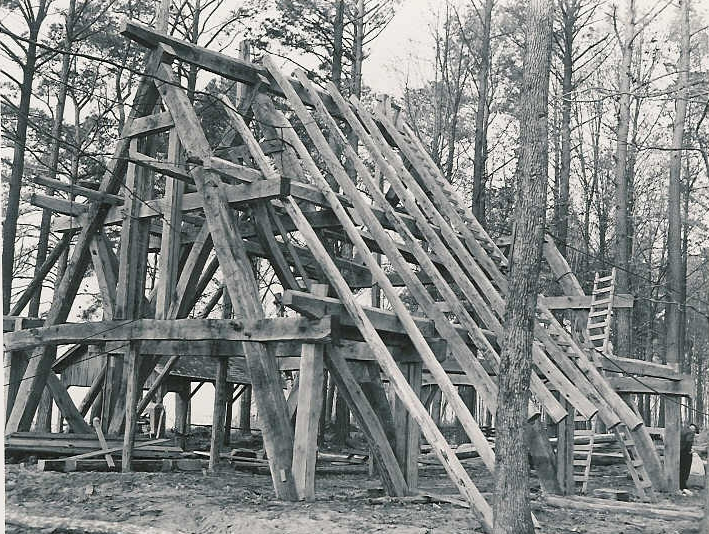
the glasshouse at Jamestown was reconstructed in 1956
Source: National Park Service, Jamestown Visitor Center
To document the historical significance of Jamestown, the Commonwealth of Virginia published 32 historical booklets about colonial Virginia. The state also built a living history site, Jamestown Festival Park, between Jamestown Island and the Scotland Ferry landing.8
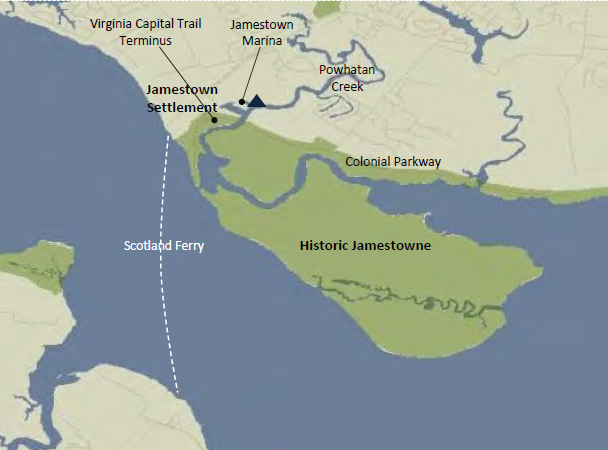
Jamestown Settlement was built by the state of Virginia for the 1957 anniversary, while the National Park Service built a visitor center at the Jamestown Tercentenary Monument next to the location of the 1607 fort
Source: National Park Service, Captain John Smith Chesapeake National Historic Trail, Making the Trail Visible and Visitor Ready: A Plan for the James River Segment
The re-creation intended to draw tourists, and was so successful that Virginia decided to keep it in operation after the 350th anniversary was over. In 1989, the state renamed it Jamestown Settlement.
The General Assembly created the Jamestown-Yorktown Foundation in preparation for the 400th anniversary in 2007. The state invested in a new museum at Jamestown Settlement, next to the 1957 recreated fort. The new museum included extensive and elaborate exhibits that reflected much greater sensitivity to cultural diversity. The roles of Native American and Africans in Virginia are now presented along with the stories of English colonists.
Modern visitors to Jamestown Settlement who move beyond the museum will pass through a site with interpreters. They describe the lives of the Paspahegh and other Native Americans who lived on the Peninsula before the English arrived. To keep costs within reason, the yi-hakins are covered with large woven mats with modern stitching, rather than reeds or bark. The interpreters may not be Native Americans, but the state has designed Jamestown Settlement so visitors must first experience the Native American community before seeing the reconstructed fort and three ships that brought the English colonists.
Preparation for the 400th anniversary spawned major new archeological investigations on Jamestown Island. The Association for the Preservation of Virginia Antiquities (which merged with Preservation Alliance of Virginia in 2004 to form today's Preservation Virginia) and the National Park Service partnered to review the results of earlier excavations, then conduct new historical and archeological research.
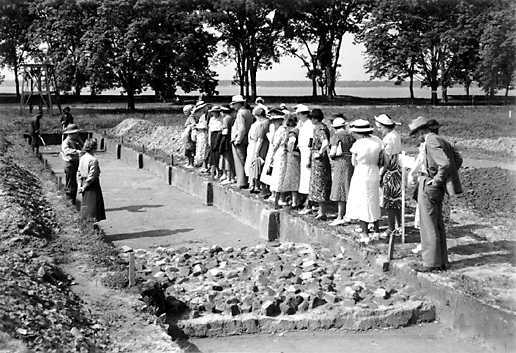
archeology at Jamestown has been used to attract tourists, as well as for research
Source: National Park Service, NPS History Collection - Colonial National Historical Park
Archeologist William Kelso was chosen to lead the Jamestown Rediscovery initiative, exploring whatever still remained at the actual settlement site. He quickly documented the existence of the original fort, and led a multi-year series of excavations that produced a stunning amount of information and artifacts.
The new research expanded understanding of how the colonists lived and interacted with various Native American groups. Careful analysis of the historical record and the archeological discoveries did not answer every question, but did reveal a much richer perspective of life at Jamestown.
Excavation of the old church site revealed the graves of Reverend Robert Hunt, Captain Gabriel Archer, Sir Ferdinando Wenman/Weyman/Wainmen, and Captain William West. Later research used DNA and historical records to determine that Sir Ferdinando Wenman/Weyman/Wainmen and Captain William West were related to Thomas West, the first Governor. Thomas West is known better by his title, Lord De la Ware.
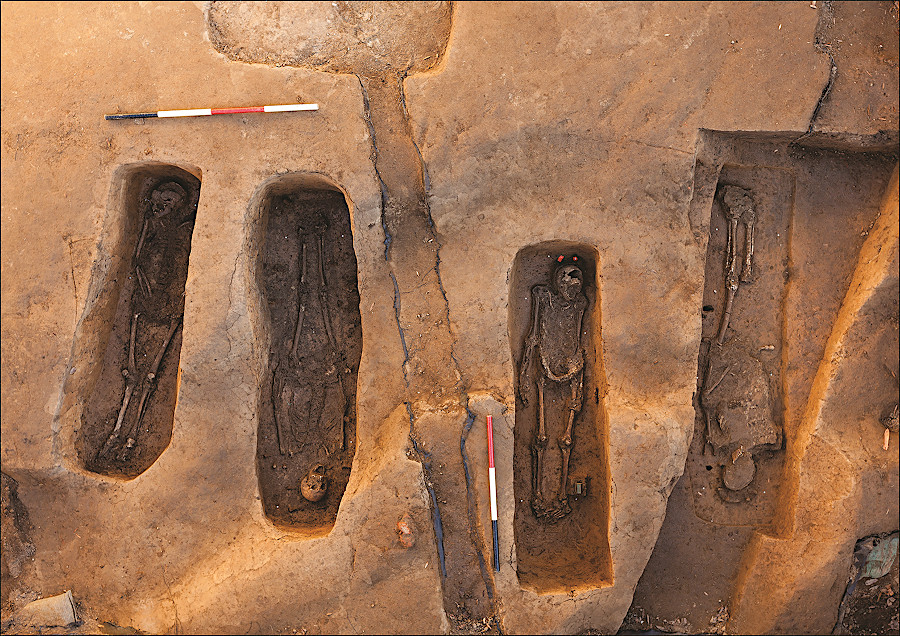
four graves of high-status colonists were excavated from the chancel within the historic Jamestown church
Source: Smithsonian Institution, Historical and archaeogenomic identification of high-status Englishmen at Jamestown, Virginia
Both Sir Ferdinando Wenman/Weyman/Wainmen and Captain William West were buried in the summer of 1610, after Lord De la Ware had arrived at Jamestown. Captain William West died on a raid against a Native American settlement near the Fall Line of the Janes River. Lord De la Ware led the raid, so he would have sailed back to Jamestown with the body of his dead kinsman.
The actual relationship between the two was published in 2024. Captain William West was the illegitimate son of Sir De La Ware's unmarried sister Elizabeth. Despite connections to a wealthy and prominent family, his social status in England was constrained by his birth.
By choosing to travel to Virginia, Captain William West created new opportunities to have a fulfilling life - except he was killed when he was only about 24 years old. His uncle, Lord De la Ware, had him buried in a place of honor with his cousin Sir Ferdinando Wenman/Weyman/Wainmen.9
The National Park Service built a new visitor center, with upgraded interpretive exhibits, after Hurricane Isabel in 2003 flooded the 1957 facility. The new National Park Service visitor center is at the parking lot, not at the location of the 1957 facility at the Jamestown Tercentenary Monument. The parking lot location is further away from the waterfront and rising sea levels
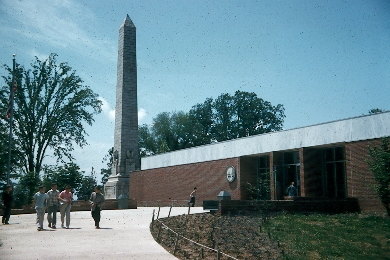
the National Park Service visitor center opened in 1957, and was removed after it flooded during Hurricane Isabel in 2003
Source: National Park Service, Jamestown Visitor Center
Preservation Virginia built perhaps the most unique museum in Virginia, the Archaearium. That structure is located on top of the burying ground of Jamestown, which is also the site of the Statehouse used by Gov. Berkeley and burned by Nathaniel Bacon in 1676.
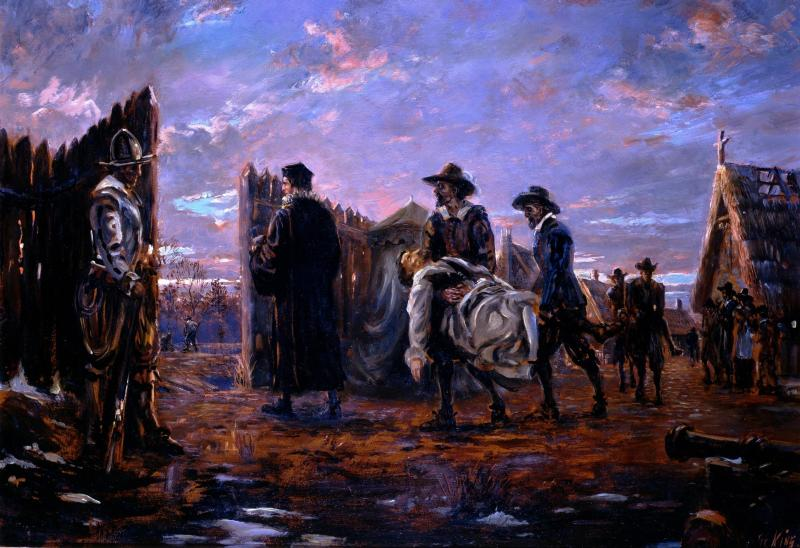
the Archaearium has exhibits that explore the lives, deaths, and burials of early colonists at Jamestown
Source: National Park Service, Jamestown - Sidney King Paintings, Burial of the Dead, 1609-10
The National Park Service, a Federal government agency, and Preservation Virginia, a non-government organization, share ownership and management of Jamestown Island. As part of their Historic Jamestowne partnership, National Park Service staff at the visitor center collect an admission fee for Preservation Virginia.
Just west of Jamestown Island, and not on the original island, the state-run Jamestown Settlement living history park is a separate operation. The state site includes a museum and visitor center, re-created Paspahegh village, reconstruction of the 1607 fort, and replicas of the Susan Constant, Godspeed, and Discovery. In 2001, the General Assembly designated the three ships as the official fleet of the Commonwealth.
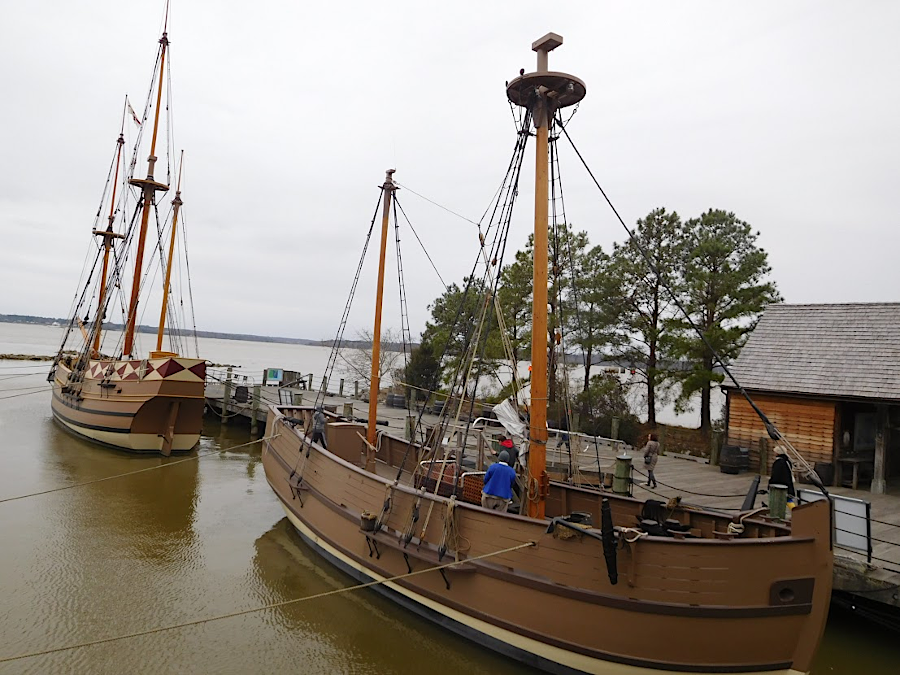
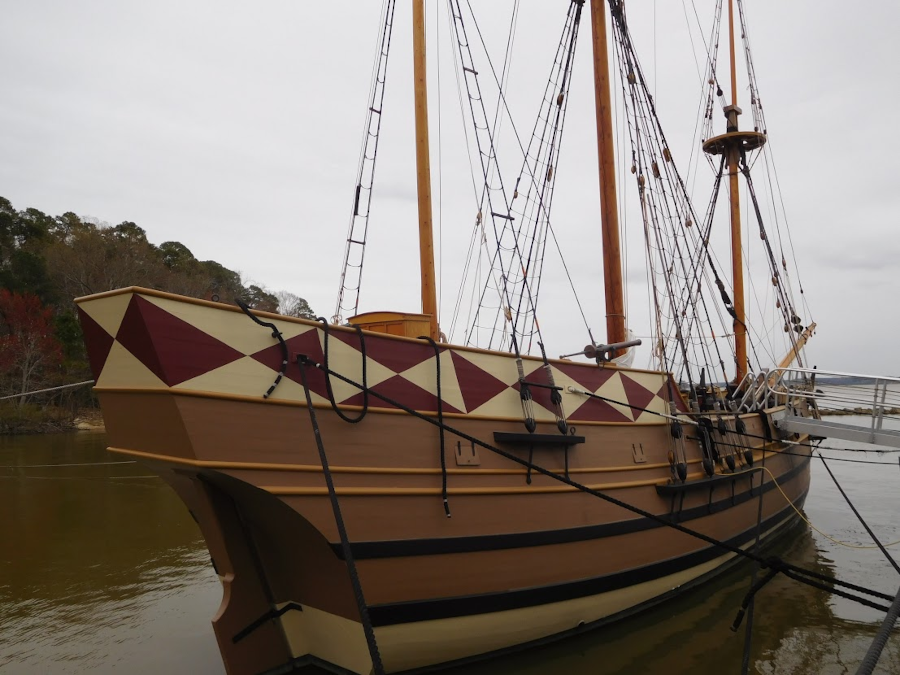
Jamestown Settlement exhibits recreations of the three ships that arrived in 1607
The first Susan Constant replica was built at Norfolk in 1957. A second ship was built at Jamestown Settlement and commissioned in 1991 to serve as a floating classroom as well as an exhibit at the dock. In 2024, that Susan Constant traveled (using diesel engines) to Mystic Seaport Museum Shipyards in Connecticut for $4.7 million restoration, including replacement of the exterior planking with new cypress.10
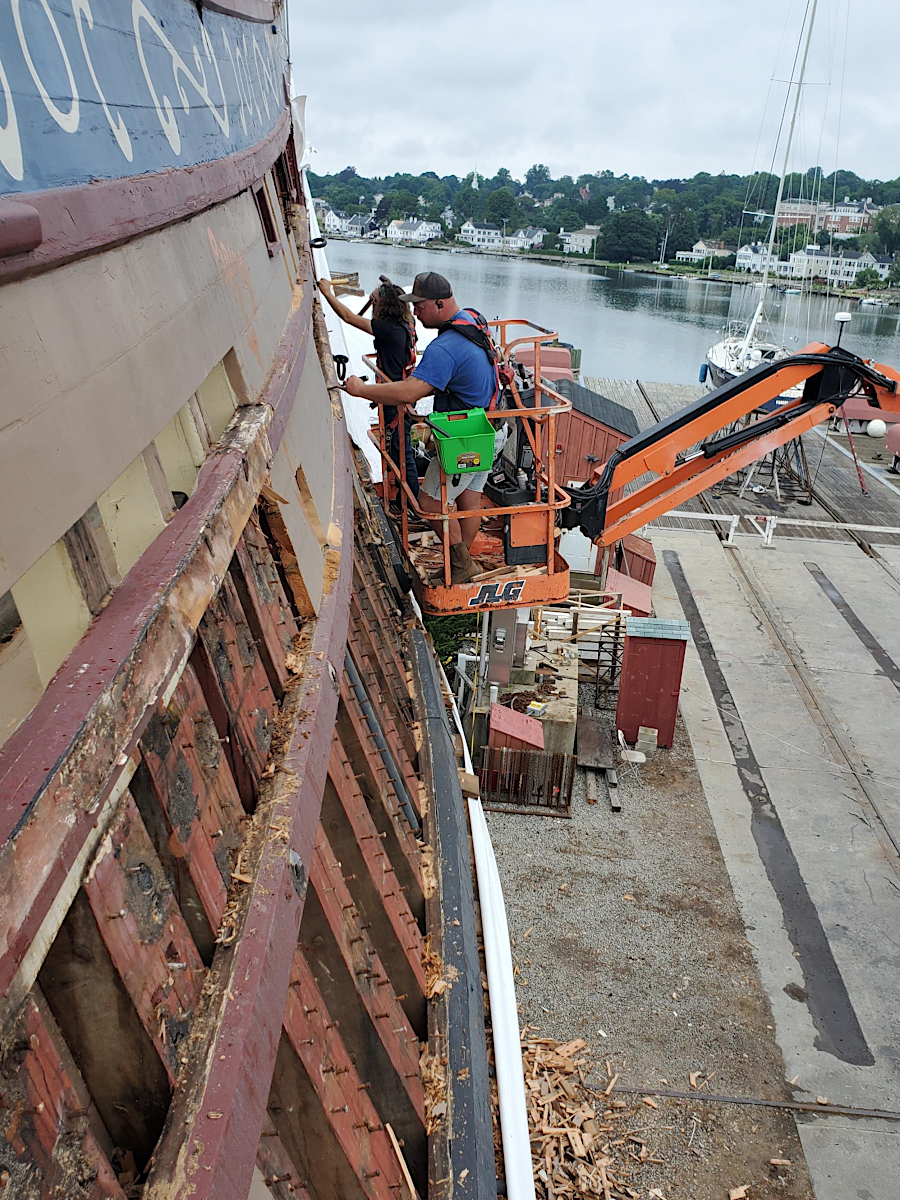
the Susan Constant was restored at Mystic Seaport Museum Shipyards in 2024-2025
Source: Jamestown-Yorktown Foundation, Susan Constant Restoration Progress (Summer 2024)
The two sites complement each other and the historical perspective in their exhibits is consistent. Visitors can go to both sites for a richer understanding of the start of English colonization in Virginia. Because vacationers typically have limited time and perhaps limited interest, Jamestown Settlement (operated by the state) and Historic Jamestowne (operated by the National Park Service and Preservation Virginia) inevitably compete with each other for visitors.
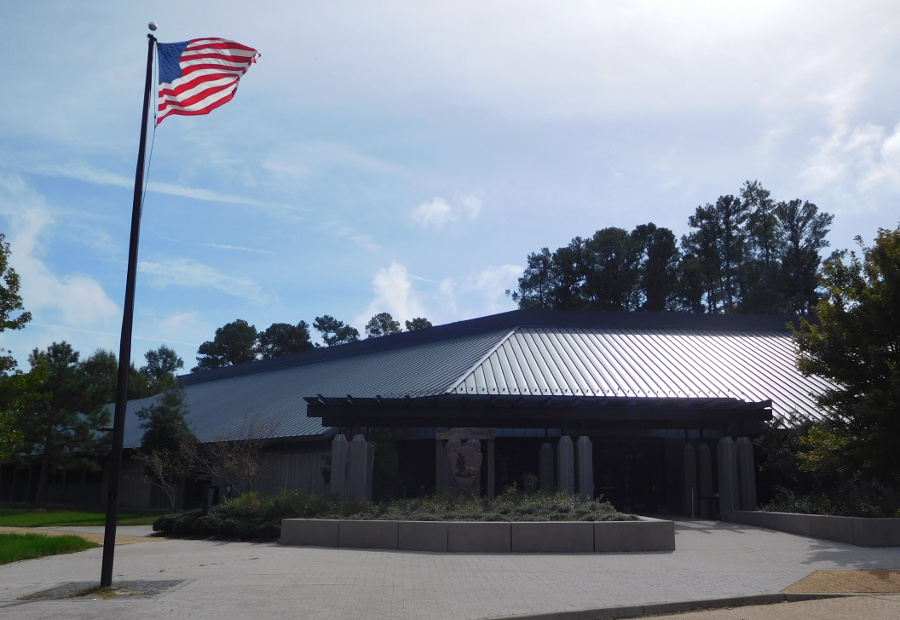
the Historic Jamestowne visitor center (not Jamestown Settlement) collects two admission fees - one each for the National Park Service and Preservation Virginia
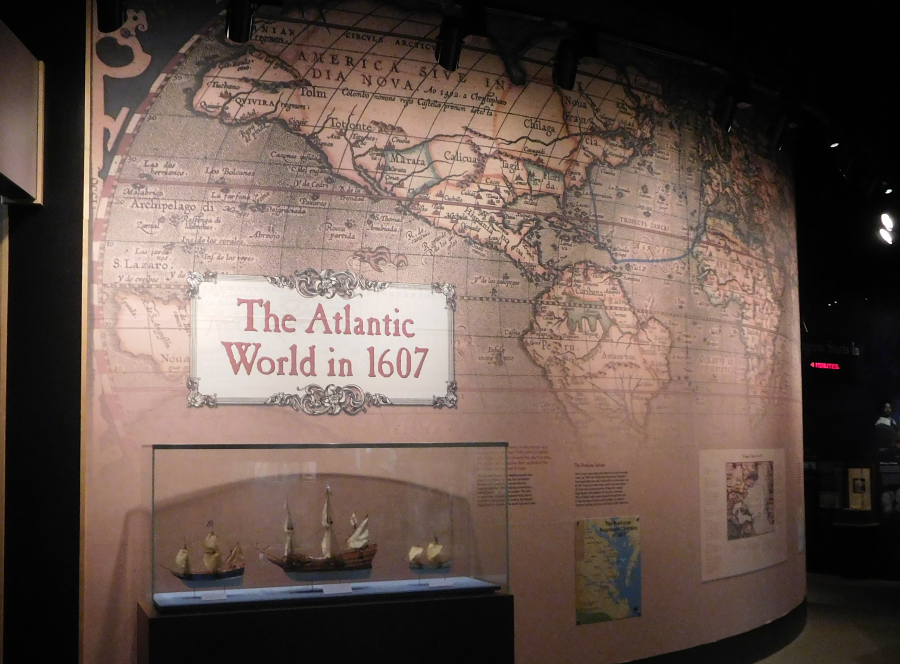
the Historic Jamestowne visitor center built by the National Park Service for the 2007 commemoration highlights a broad "Atlantic World" context, with a blending of English, Native American, and African cultures
The General Assembly provided funding to the Jamestown-Yorktown Foundation to commemorate several 400th anniversaries in 2019, to highlight the state's heritage and to attract tourists. The Jamestown-Yorktown 2019 Commemoration was planned to highlight four major milestones:
The legislature added $11 million to the state agency's budget in 2016 and proposed another $10 million addition in 2017. The governor made a political point by trying to reduce that amount to $5 million and direct the remainder towards on health care services, but the General Assembly did not concur.10
Long term, Jamestown Island may not last long enough to commemorate its 500th anniversary. The tidal portion of the James River there is at sea level; most of the island is now just three feet above that. When John Smith and others arrived in 1607, the island was four feet higher. The first road constructed in Virginia, the Greate Road leading west from the fort, is now below the Pitch & Tar Swamp. Marine archeology was required to identify the road's location between the modern Tercentennial Monument and Archaearium museum.
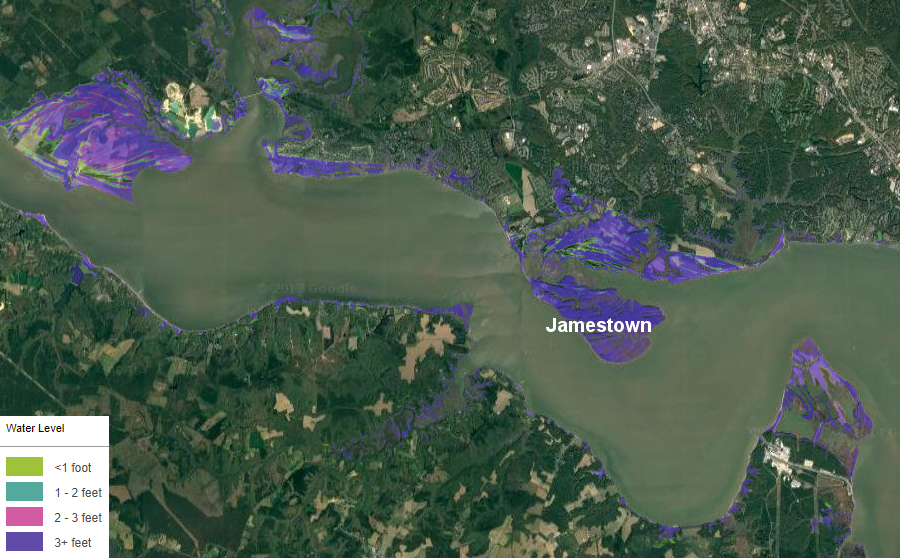
a Category 3 hurricane would flood Jamestown Island under three feet of water
Source: First Street Foundation, FloodIQ
Because the land in southeastern Virginia is also subsiding, the island could be completely submerged in 2107. Long before then, storm tides will force an increasing number of closures to public visits. The Archaearium is elevated, but Preservation Virginia's immediate approach for the fort and church is to built a temporary barrier of sandbags.
In 2022, the National Trust for Historic Preservation included Jamestown on the annual list of "11 Most Endangered Historic Places." The Jamestown Rediscovery Foundation's "Save Jamestown" campaign received a boost in 2024 when Norfolk Southern donated $1 million. Total estimated costs to protect the island are $30 million.
A high priority is further archeological research at Smith's Field, the site between the restored fort and Archaearium where John Smith probably drilled his troops. Suspected burials in the field are thought to date to the 1620's, and there is evidence of slave quarters built in the 18th and early 19th centuries. The 22.5 acres on the island owned by Preservation Virginia include Smith's Field.11
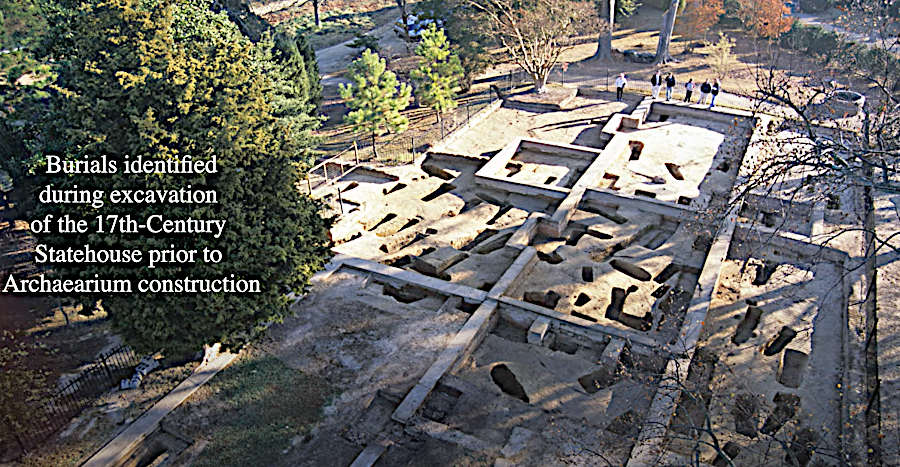
careful archeology revealed graves and the foundations of the Statehouse before the Archaearium museum was constructed on the third ridge at Jamestown
Source: Jamestown Rediscovery, Dig Deeper Episode 72 - 2024 Summer Field School and Exciting Finds on the Statehouse Ridge
To protect the resource, Jamestown Rediscovery's #1 priority is to repair the existing historic seawall before the James River begins to carve into the historic site. Sea level rise and more-intense rainfall is creating an existential threat to Jamestown:12
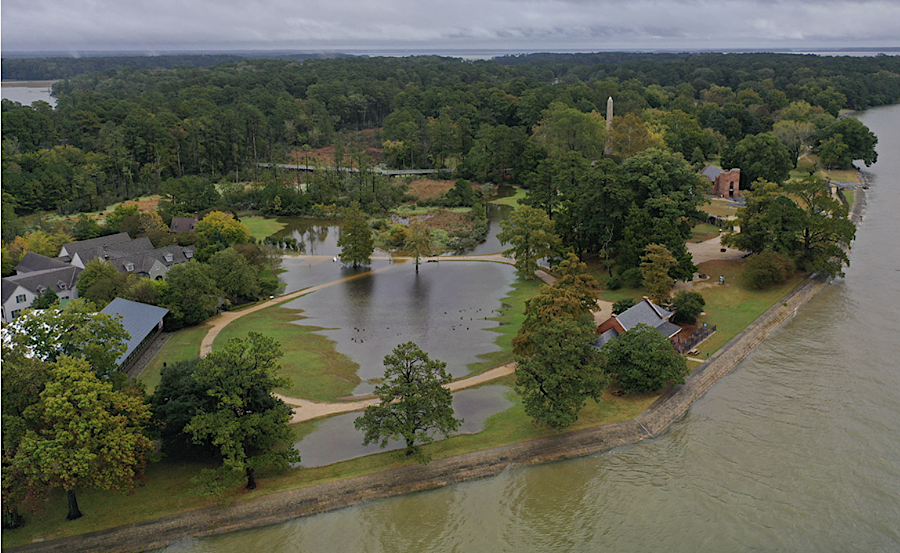
burial sites of early Jamestown colonists are now inundated during high water, as in October 2021 after a nor'easter
Source: Jamestown Rediscovery, Save Jamestown
Flooding will affect how archeologists extract the history of Jamestown in the 1600's from the ground; the bones and artifacts still remaining within graves decay rapidly after being inundated. The greatest risk is that rising water will destroy evidence of the less-influential members of society:13
Federal support to preserve Jamestown was eliminated after President Trump started his second term in 2025. A $300,000 National Endowment for the Humanities grant was cancelled, ending funding for hydrological surveys and planning efforts to mitigate flooding. The Jamestown Rediscovery Foundation president was clear about the future:14
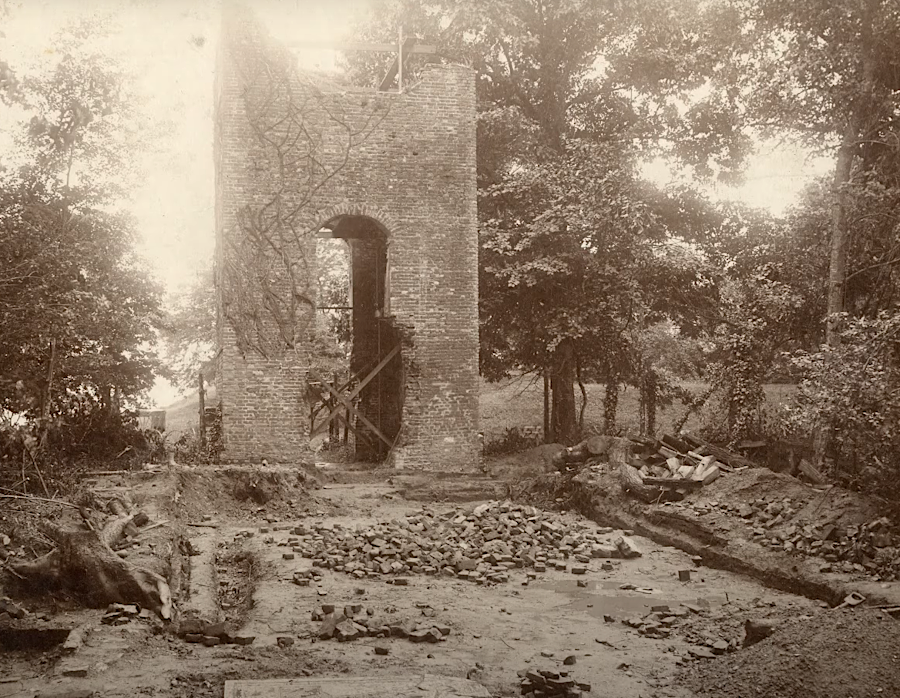
the Association for the Preservation of Virginia Antiquities initiated the first archeological excavations of the church site
Source: Jamestown Rediscovery, Dig Deeper Episode 1: The Jamestown Church Exhibit
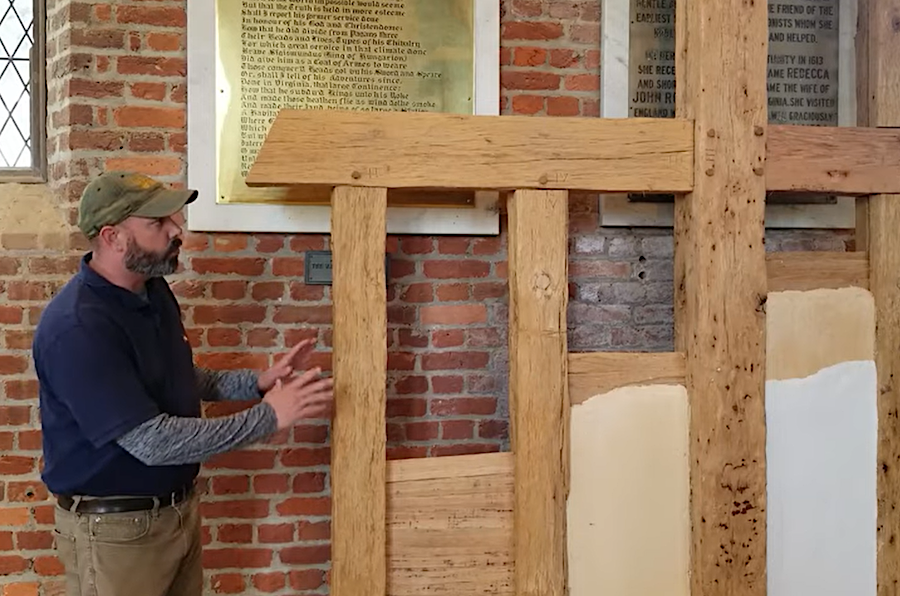
modern archeological research has guided recreation of the 1617 timber-framed church, inside the walls of the reconstructed 1639 brick church
Source: Jamestown Rediscovery, Dig Deeper Episode 1: The Jamestown Church Exhibit
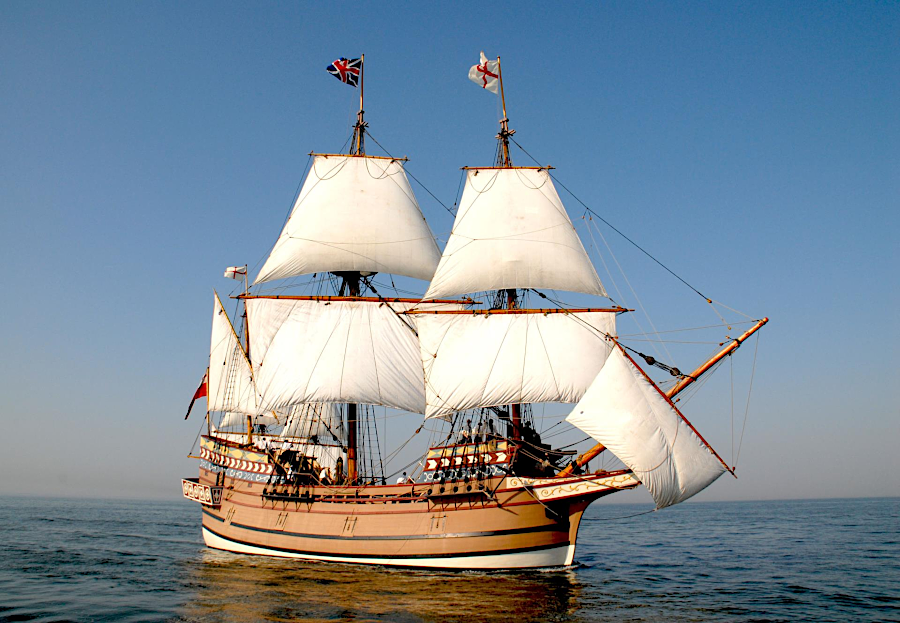
1990 replica of the square-rigged Susan Constant, sailing on Chesapeake Bay in 2007 and showing four gunports on starboard side
Source: Jamestown-Yorktown Foundation, Susan Constant History